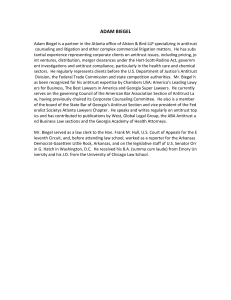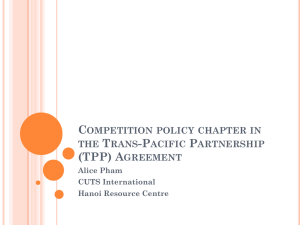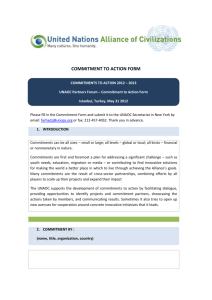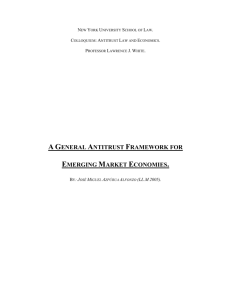DOC - Europa
advertisement
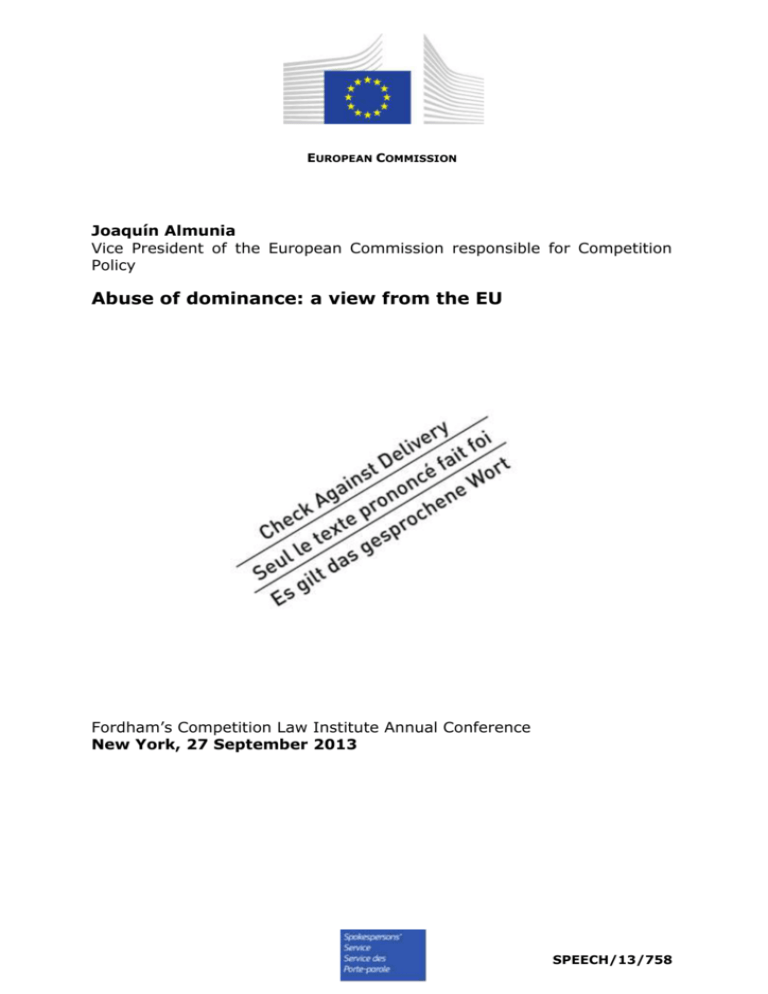
EUROPEAN COMMISSION Joaquín Almunia Vice President of the European Commission responsible for Competition Policy Abuse of dominance: a view from the EU Fordham’s Competition Law Institute Annual Conference New York, 27 September 2013 SPEECH/13/758 Ladies and Gentlemen: I thank Barry Hawk for giving me the opportunity to speak once again at Fordham’s annual competition conference. This year I’m especially happy to be here because this conference turns 40. Congratulations! I remember well my feelings when I crossed this line 25 years ago. This was when I realised that I had definitely entered maturity, which is when one finds the balance between experience and new opportunities. I am sure you have similar feelings, as a group organising this event. I want to thank Fordham's Competition Law Institute and all the people that make this event happen for their splendid achievement and I wish you every success for the future. I have been asked to talk about unilateral conduct enforcement and policy – what we call in the EU ‘abuse of dominance’ or ‘Article 102’, from the article of the EU Treaty that covers the practice. In the early years of European integration, there were doubts about the scope of this Article. Then, in 1973 – by coincidence, also 40 years ago – the European Court of Justice made it clear – in the seminal Continental Can case – that the provision was not only about practices that harm consumers directly, such as excessively high prices, but also about practices that harm consumers indirectly though their impact on competition; the so-called exclusionary conduct. Ever since this clarification, the provision has played a big role in the liberalisation of EU markets through the 80s and 90s, when many incumbents across the continent were state-owned. At first, enforcement focussed on basic industries and consumer goods, such as in the milestone cases involving Hoffman La Roche, Hilti and Tetra Pak, respectively concerning vitamins, nail guns and drink cartons. Later, when economic theories started to pad antitrust analysis, the searchlight fell upon network industries and more complex markets. Thanks to the constant dialogue between our respective competition authorities, nowadays there is a similar understanding on unilateral-conduct enforcement across the Atlantic. We share the view that it is primarily about fighting against foreclosure and exclusion of competitive firms by dominant ones; We also agree on the fundamental objective of antitrust laws and policies; that is, to ensure consumer welfare in terms of price, quality, innovation and choice; and We believe that a sound analysis based on economic effects is crucial to this end. That being said, some aspects of our abuse of dominance action are specific to the EU. Most differences stem from the fact that establishing a single European market is the wider objective within which EU competition policy is enforced, with rules designed to tear down and prevent internal trade barriers raised by anti-competitive practices. And since our Treaty does not confine the notion of abuse to specific forms of behaviour, we can employ Article 102 to keep in check a variety of practices that endanger competition. 2 Sometimes this allows us to intervene in cases not covered by US law. Exploitative abuse is the most obvious example. Because the notion of abuse in Europe covers not only exclusionary practices, such as refusal to deal, but also exploitative practices, such as unfair or excessive pricing, we can act directly against dominant firms that overcharge for their products or services. This is not always easy to tell, of course. When is a price ‘unfair’? The European Court of Justice offered guidance as far back as 1978. In the United Brands case, it ruled that one would need to establish firstly that the profit margin of the dominant firm is very high by considering the difference between its costs and prices, and secondly that this high margin is not the result of superior efficiency, by comparing it with the prices charged by competitors. Later on, the Court also considered other methods. A case that can illustrate this type of concern is our on-going investigation of the Russian energy giant Gazprom. One of the key issues in this case is that Gazprom may have imposed unfairly high prices on its customers in Central and Eastern Europe when compared to costs or to competitive benchmarks. Gazprom’s market power allows it to conduct a pricing policy which we suspect is out of line with market fundamentals. We are concerned that the resulting large price differences across Europe were maintained through territorial restrictions in gas supply agreements and attempts to foreclose other gas suppliers. Another aspect of Article 102 that I wish to point out is the fact that the provision applies to state-controlled and private companies alike. It is indifferent to who owns the company suspected of an abuse or how it is financed. This allows us to intervene in cases where the dominant companies are controlled by the state. In newly liberalised markets, we have seen many incumbents trying to leverage their remaining monopoly power and adopt exclusionary practices to delay the entry of rivals in markets. Look at telecommunications for instance. We have had cases involving old incumbents in Germany, Spain, or Poland – and other cases are in the pipeline. The same goes for the energy sector, where our action has aimed at preventing the exclusion of rivals and opening national markets to competition, such as in Belgium, Germany, France or Italy. Let me add that enforcement actions are also taken by competition authorities in the Member States, on the basis of EU law, and most of them take place in other newly liberalised sectors, including transport and postal services. When the legislator opens up a market, it is our responsibility to make sure that old incumbents do not try to occupy it again from the back door. And, vice versa, our actions sometimes show the need for legislative action. Ladies and Gentlemen: The competition-law provisions of the Treaty of Rome were drafted several decades after those of the Sherman act. The different economic and political context in which they were born, the different institutional settings, and the different legal traditions explain the development of antitrust enforcement in the US and that of competition enforcement in the EU. 3 One of these differences has to do with refusal to deal. Competition agencies in the US seem more reluctant to intervene in these cases because they are concerned with the risk that competitors can free ride on the investments of the dominant company, thus undermining the incentives to innovate. I think that fostering innovation is one of the main objectives of competition policy. However, we intervene if a dominant company refuses to supply indispensable input and eliminates competition in the market where this input is used. This was illustrated in our first Microsoft case, which concerned the company’s refusal to supply Windows interoperability information. The practice threatened to eliminate effective competition on the group-server market. A related unilateral conduct which we approach differently is margin squeeze. In our jurisprudence this practice is a standalone abuse. In Europe margin squeeze often involves former state monopolies charging a high access price to circumvent a regulatory obligation to supply. We have investigated margin squeeze in the telecom sector, notably in Spain in the Telefónica case, and we are currently investigating a similar conduct by Slovak Telekom, the incumbent in Slovakia. In the rail sector, we are also looking into this type of conduct in a case involving the German incumbent Deutsche Bahn in the rail freight market. In contrast, in the US margin squeeze is not considered an independent form of abuse. The Supreme Court judgment in Linkline of 2009 makes it clear that the conduct can be pursued, but rather as a regulatory duty to deal or as predatory pricing. These are two of the differences in how EU and US competition authorities deal with unilateral conduct. But overall these are less of a problem today, especially thanks to an increased reliance in Europe on the economic analysis of the effects that the suspected infringements would have on the markets. Now I will turn to the challenges posed by unilateral conduct in high-tech markets, which pose fresh problems to enforcers. US and EU authorities often show a common approach in these markets. For instance, in the so-called ‘patent wars’ among smartphone manufacturers and the way injunctions are used against competitors. We both share the view that a FRAND commitment given in a standardisation context means that the holder of standard-essential patents can no longer issue an injunction if the licensee is willing to negotiate a FRAND licence. This issue is at the heart of a case we currently have in Brussels involving Samsung. The company committed to a standards body to license its standard-essential patents to market participants in return for reasonable remuneration. But later, the company sought injunctions based on those patents although in our view there was a willing licensee. Last December, we sent Samsung a Statement of Objections which outlined our concern that its conduct was anti-competitive. After lengthy discussions, Samsung has sent us a set of commitments seeking to address our concerns. 4 We will formally market test these proposed commitments with other market participants in the coming weeks. If we then conclude that the commitments address our concerns, we will take a commitment decision which would – I believe – bring clarity on SEPs and injunctions across the industry. I would also like to add a general comment on our action in high-tech sectors. Some claim that there is no need for antitrust intervention in high-tech markets. As you may remember, this is what Microsoft argued in its antitrust cases here as in the EU. The argument is that it is impossible for a company to become dominant – and to stay dominant – in sectors where new products, platforms and services appear all the time. I’m not convinced by this argument. In fact, owing to some specific features of these markets, it can actually be easier for a company to hold a dominant position over time. One such feature is network effects, which tend to reinforce the position of market leaders. These effects can make markets become highly concentrated and can impose significant barriers to entry. Similarly, switching costs may prevent the displacement of market leaders because customers are locked in. In sum, dynamic industries are not immune to careful antitrust scrutiny, nor should the basic antitrust principles be modified. Price fixing, foreclosure, market partitioning, and so on can and will still harm consumers in the digital economy. Another aspect that is often debated in our high-tech cases is the relative merits of commitment and prohibition decisions. Are we, as a matter of principle, in favour of using Art. 9 of EU Antitrust regulation or is it better to go through the route offered by its Art. 7? There is no general principle that can direct our thinking one way or another when we start to look into a potentially anti-competitive practice. We always investigate our antitrust cases using the full range of tools. Here I would like to recall that when a company offers commitments, the Commission has full discretion to decline them and revert to a prohibition procedure if the discussions that follow prove unsuccessful and if we are not satisfied with the outcome of the market test. So, what are the relative merits of prohibition and commitment decisions? Generally, decisions to prohibit anticompetitive practices and impose fines have a strong deterrent effect and a precedent value. They are also more helpful to victims of antitrust violations who seek to obtain damage compensation in courts. Prohibition decisions are also preferable when we have to sanction past behaviour or when there is no remedy available to solve the competition problem other than an order to "cease and desist". Let me remind you that fines are not limited to cartel cases in the EU. The Commission has imposed fines in nine cases over the last ten years – including our decisions on Microsoft and Telefónica, which were upheld by the Court. As to the decisions to accept the commitments proposed by a company, the main advantage is that we can take them in a much shorter time. This means, that we can use them to solve competition concerns quickly and have an immediate impact on the market. 5 This is why many associate commitments to fast-moving markets, where swift decisions are key for effective enforcement. One example is the e-book decision we adopted in December last year. But commitments can also be very effective in sectors – such as energy – where structural measures are needed. Our EON decision of 2008 and our ČEZ decision last April were both commitment decisions. When we accept commitments from a company, they will avoid paying a fine. But we’ve always been clear that these pledges, which we make legally binding, must be kept at all times. If a company does not comply with the commitments, we can impose a fine – and we can do so without having to prove any violation of competition rules. As you know, the first fine of this kind was imposed on Microsoft earlier this year for an amount of €561 million. Ladies and Gentlemen: I have come to the end of my review of unilateral conduct enforcement and policy in Europe and America. In closing, I can tell you that – in my experience as Commissioner for Competition – I have never seen our remaining differences block our cooperation on any individual case. It is our responsibility to recognise and understand our respective systems and move on. We often investigate the same problems, apply similar analyses and find similar remedies. I am determined to advance along this path together with our colleagues in the US. We will continue to exchange views, coordinate our work on the cases of common interest, and push our cooperation towards ever higher levels. Thank you. 6





